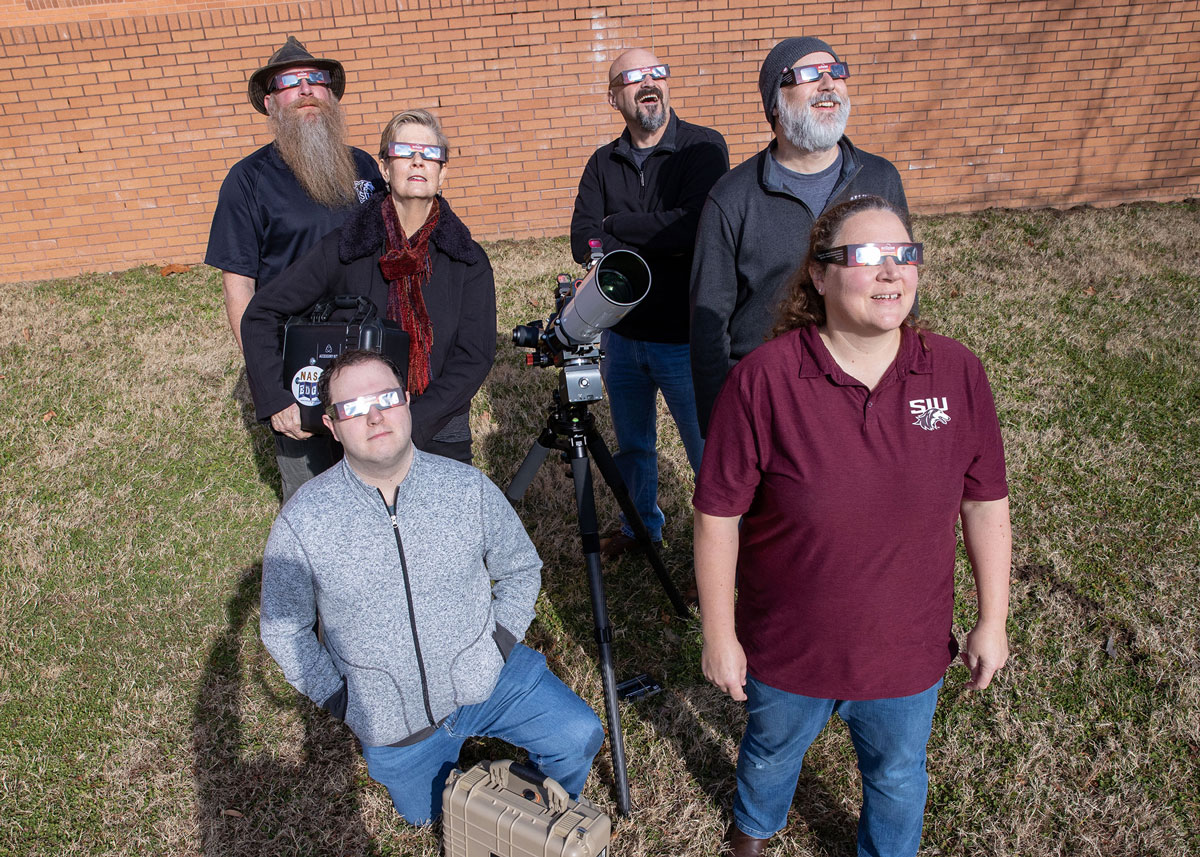
A team of researchers from Southern Illinois University Carbondale and beyond are creating a multifaceted, national heliophysics public engagement and empowerment program centered on the April 8 total solar eclipse and related events, including those at SIU. Team members include, left side, top to bottom: Chris Mandrell, Karla Berry and Richard Danely; right side, top to bottom: Harvey Henson, Bob Baer and Cori Brevik.
January 11, 2024
SIU gets $2.6M grant to use celestial marvels as inspiration to study the sun
CARBONDALE, Ill. – Of all the objects in Earth’s sky, nothing impacts humans more than the sun. Researchers at Southern Illinois University Carbondale are playing a key role to inspire curiosity about our fiery celestial neighbor.
NASA is sending the SIU team more than $2.6 million for the SolarSTEAM project. The grant, which runs August 2023 through June 2026, will pay for a multifaceted, national heliophysics public engagement and empowerment program centered on the April 8 total solar eclipse and related events, including those at SIU.
The upcoming total solar eclipse will mark the second time since 2017 that SIU’s campus has been in the path of totality. The university currently is making preparations for the large public and science-rich events in and around the university.
SolarSTEAM makes the sun mainstream
Harvey Henson, associate professor in the School of Education and director of SIU’s STEM Education Research Center, will lead the multi-agency team on the project as its principal investigator. Additional SIU researchers on the project include Bob Baer, Cori Brevik and Matt Penn in the School of Physics and Applied Physics, Karla Berry in the School of Media Arts, and Justin McDaniel in the School of Human Sciences.
Other agencies providing researchers to the SolarSTEAM project include NASA Langley Research Center, Adler Planetarium, Aries-Scientific Inc. and Johns Hopkins University Applied Physics Laboratory.
SolarSTEAM (with STEAM standing for science, technology, engineering, arts and mathematics) builds on research and outreach experiences from the 2017 eclipse and will focus on heliophysics, the study of the sun and its influence on space and a critical science that affects daily life, Henson said.
“We start with a basic goal: making heliophysics a household word in America,” he said. “We want to move the public from a state of recognizing the sun, moon and planets to an understanding of what they are and how they impact our lives.”
Accomplishing this goal will empower Americans nationwide to take part in historic events and discoveries, as personally invested partners in the story of NASA Heliophysics, Henson said.
“Our team of researchers builds on 20-plus years of experience in public engagement through highly successful programming, including events such as the Transit of Venus, the 2017 solar eclipse that hit us here in Southern Illinois, as well, and the Sun-Earth Days,” Henson said. “These were all exemplary, large-scale public astronomy and outreach programs.”
Henson credited Baer with bringing focus to the opportunities presented by the two eclipse events over Southern Illinois.
“Most of the heliophysics research success, and certainly credit for eclipse awareness at SIU goes to Bob Baer, who I call Mr. Eclipse,” Henson said. “Not too many people in Carbondale would have known anything about the two eclipse events without him working so hard.”
Many aspects
The project includes plans to hold large annual, thematic events tied to popular heliophysics phenomena, such as lunar and solar eclipses, solar maximum (the peak of solar activity in the sun’s approximately 11-year cycle) and NASA missions. The team will focus on reaching people of all backgrounds nationwide by offering simultaneous face-to-face experiences and online programming such as NASA EDGE and the Adler Planetarium’s Sky Observers Hangout, along with coordinated social media efforts.
“Our thematic, big events will feature in-person anchor locations and remote streams from citizen science observations, live scope feeds and personal interviews from diverse populations,” Henson said.
Additional plans call for nationwide annual “star parties” infused with NASA heliophysics content, including both solar and night observations, with a student-led astrophotography STEAM team providing enhanced solar and celestial imagery capacity.
The team also will provide information about science careers with personal interviews with NASA experts on NASA EDGE programs, online programming, social media and radio. Adler Planetarium will provide heliophysics-themed videos and other visualizations tied to actual events for national distribution to museums, planetariums and amateur astronomy clubs.
Furthermore, the team will work with the Astronomical League to develop a solar observation certificate program and awards for amateur astronomers, and researchers will develop engagement tools and activities providing heliophysics content and distribute it online and in libraries.
“We’re building on partnerships and team members’ experiences that have created historical engagement levels,” Henson said.
